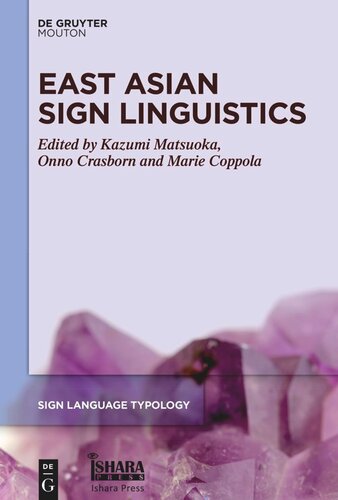

Most ebook files are in PDF format, so you can easily read them using various software such as Foxit Reader or directly on the Google Chrome browser.
Some ebook files are released by publishers in other formats such as .awz, .mobi, .epub, .fb2, etc. You may need to install specific software to read these formats on mobile/PC, such as Calibre.
Please read the tutorial at this link: https://ebookbell.com/faq
We offer FREE conversion to the popular formats you request; however, this may take some time. Therefore, right after payment, please email us, and we will try to provide the service as quickly as possible.
For some exceptional file formats or broken links (if any), please refrain from opening any disputes. Instead, email us first, and we will try to assist within a maximum of 6 hours.
EbookBell Team

4.0
6 reviewsThis book is one of the first references of linguistic research of sign languages in East Asia (including China, Korea, Japan, Taiwan, and Hong Kong). The book includes the basic descriptions of aspects of Chinese (Shanghai, Tianjin) sign language, Hong Kong Sign Language, Japanese Sign Language, Korean Sign Language, Taiwanese Sign Language, and Tibetan Sign Language.
Table of contents
Introduction
Kazumi Matsuoka, Onno Crasborn and Marie Coppola
Part 1: Manuals: Numerals, classifiers, modal verbs
Historical relationships between numeral signs in Japanese Sign Language, South Korean Sign Language and Taiwan Sign Language
Keiko Sagara
Phonological processes in complex word formation in Shanghai Sign Language
Shengyun Gu
Classifiers and gender in Korean Sign Language
Ki-Hyun Nam and Kang-Suk Byu
Causative alternation in Tianjin Sign Language
Jia He and Gladys Tan
Epistemic modal verbs and negation in Japanese Sign Language
Kazumi Matsuoka, Uiko Yano and Kazumi Maegawa
Part 2: Non-manuals and space
The Korean Sign Language (KSL) corpus and its first application on a study about mouth actions
Sung-Eun Hong, Seong Ok Won, Hyunhwa Lee, Kang-Suk Byun and Eun-Young Lee
Negative polar questions in Hong Kong Sign Language
Felix Sze and Helen Le
Analyzing head nod expressions by L2 learners of Japanese Sign Language: A comparison with native Japanese Sign Language signers
Natsuko Shimotani
Composite utterances in Taiwan Sign Language
Shiou-fen Su
Time and timelines in Tibetan Sign Language (TSL) interactions in Lhasa
Theresia Hofer